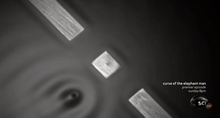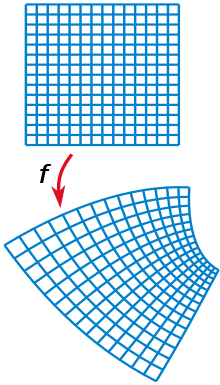Couder experiments, "materializing" the pilot wave model.
In theoretical physics, the pilot wave theory, also known as Bohmian mechanics, was the first known example of a hidden variable theory, presented by Louis de Broglie in 1927. Its more modern version, the de Broglie–Bohm theory, interprets quantum mechanics as a deterministic theory, avoiding troublesome notions such as wave–particle duality, instantaneous wave function collapse, and the paradox of Schrödinger's cat but introducing nonlocality.
The de Broglie–Bohm pilot wave theory is one of several equally valid interpretations of (non-relativistic) quantum mechanics. An extension to the relativistic case has been developed since the 1990s.
History
In his 1926 paper, Max Born suggested that the wave function of Schrödinger's wave equation represents the probability density of finding a particle. From this idea, de Broglie developed the pilot wave theory, and worked out a function for the guiding wave. Initially, de Broglie proposed a double solution approach, in which the quantum object consists of a physical wave (u-wave) in real space which has a spherical singular region that gives rise to particle-like behaviour; in this initial form of his theory he did not have to postulate the existence of a quantum particle. He later formulated it as a theory in which a particle is accompanied by a pilot wave. He presented the pilot wave theory at the 1927 Solvay Conference. However, Wolfgang Pauli raised an objection to it at the conference, saying that it did not deal properly with the case of inelastic scattering. De Broglie was not able to find a response to this objection, and he and Born abandoned the pilot-wave approach. Unlike David Bohm years later, de Broglie did not complete his theory to encompass the many-particle case. The many-particle case shows mathematically that the energy dissipation in inelastic scattering could be distributed to the surrounding field structure by a yet-unknown mechanism of the theory of hidden variables.In 1932, John von Neumann published a book, part of which claimed to prove that all hidden variable theories were impossible. This result was found to be flawed by Grete Hermann three years later, though this went unnoticed by the physics community for over fifty years
.
In 1952, David Bohm, dissatisfied with the prevailing orthodoxy, rediscovered de Broglie's pilot wave theory. Bohm developed pilot wave theory into what is now called the de Broglie–Bohm theory. The de Broglie–Bohm theory itself might have gone unnoticed by most physicists, if it had not been championed by John Bell, who also countered the objections to it. In 1987, John Bell rediscovered Grete Hermann's work, and thus showed the physics community that Pauli's and von Neumann's objections "only" showed that the pilot wave theory did not have locality.
Yves Couder and co-workers in 2010 discovered a macroscopic pilot wave system in the form of walking droplets. This system exhibits behaviour of a pilot wave, heretofore considered to be reserved to microscopic phenomena.
The pilot wave theory
Principles
(a) A walker
in a circular corral. Trajectories of increasing length are
colour-coded according to the droplet’s local speed (b) The probability
distribution of the walker’s position corresponds roughly to the
amplitude of the corral’s Faraday wave mode.
The pilot wave theory is a hidden variable theory. Consequently:
- the theory has realism (meaning that its concepts exist independently of the observer);
- the theory has determinism.
A collection of particles has an associated matter wave, which evolves according to the Schrödinger equation. Each particle follows a deterministic trajectory, which is guided by the wave function; collectively, the density of the particles conforms to the magnitude of the wave function. The wave function is not influenced by the particle and can exist also as an empty wave function.
The theory brings to light nonlocality that is implicit in the non-relativistic formulation of quantum mechanics and uses it to satisfy Bell's theorem. These nonlocal effects can be shown to be compatible with the no-communication theorem, which prevents use of them for faster-than-light communication, and so is empirically compatible with relativity.
Mathematical foundations
To derive the de Broglie–Bohm pilot-wave for an electron, the quantum Lagrangian is the potential energy,
is the potential energy,  is the velocity and
is the velocity and  is the potential associated with the quantum force (the particle being
pushed by the wave function), is integrated along precisely one path
(the one the electron actually follows). This leads to the following
formula for the Bohm propagator:
is the potential associated with the quantum force (the particle being
pushed by the wave function), is integrated along precisely one path
(the one the electron actually follows). This leads to the following
formula for the Bohm propagator:
 .
.
Derivation of the Schrödinger equation
Pilot Wave theory is based on Hamilton–Jacobi dynamics rather than Lagrangian or Hamiltonian dynamics. Using the Hamilton–Jacobi equationConsider a classical particle – the position of which is not known with certainty. We must deal with it statistically, so only the probability density
 is known. Probability must be conserved, i.e.
is known. Probability must be conserved, i.e.  for each
for each  . Therefore, it must satisfy the continuity equation
. Therefore, it must satisfy the continuity equation
 is the velocity of the particle.
is the velocity of the particle.
In the Hamilton–Jacobi formulation of classical mechanics, velocity is given by
 where
where  is a solution of the Hamilton-Jacobi equation
is a solution of the Hamilton-Jacobi equation
 and
and  can be combined into a single complex equation by introducing the complex function
can be combined into a single complex equation by introducing the complex function  , then the two equations are equivalent to
, then the two equations are equivalent to
with
 , the usual potential with an extra quantum potential
, the usual potential with an extra quantum potential  . The quantum potential is the potential of the quantum force, which is proportional (in approximation) to the curvature of the amplitude of the wave function.
. The quantum potential is the potential of the quantum force, which is proportional (in approximation) to the curvature of the amplitude of the wave function.
Mathematical formulation for a single particle
The matter wave of de Broglie is described by the time-dependent Schrödinger equation:
By plugging this into the Schrödinger equation, one can derive two new equations for the real variables. The first is the continuity equation for the probability density
 :
:
Ordinary quantum mechanics and pilot wave theory are based on the same partial differential equation. The main difference is that in ordinary quantum mechanics, the Schrödinger equation is connected to reality by the Born postulate, which states that the probability density of the particle's position is given by
 . Pilot wave theory considers the guidance equation to be the fundamental law, and sees the Born rule as a derived concept.
. Pilot wave theory considers the guidance equation to be the fundamental law, and sees the Born rule as a derived concept.The second equation is a modified Hamilton–Jacobi equation for the action
 :
:
One can also combine the modified Hamilton–Jacobi equation with the guidance equation to derive a quasi-Newtonian equation of motion
Mathematical formulation for multiple particles
The Schrödinger equation for the many-body wave function is given by
is given by



![K^Q(X_1, t_1; X_0, t_0) = \frac{1}{J(t)^ {\frac{1}{2}} } \exp\left[\frac{i}{\hbar}\int_{t_0}^{t_1}L(t)\,dt\right].](https://wikimedia.org/api/rest_v1/media/math/render/svg/74e9e0c0f1cf84bbbc58fe3e8f5d6eb0b27b4198)



























